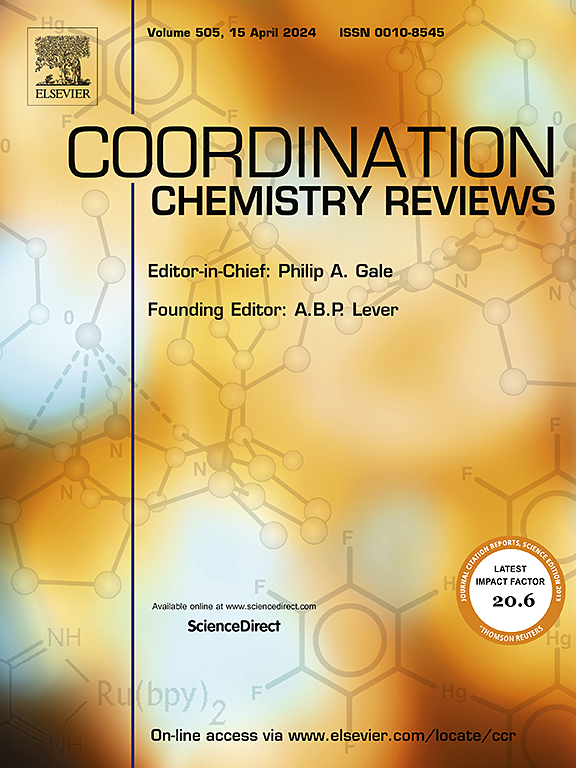甲酸配体:金属有机骨架的金属氧化物簇节点的信息探针
IF 23.5
1区 化学
Q1 CHEMISTRY, INORGANIC & NUCLEAR
引用次数: 0
摘要
小分子探针(如一氧化碳、甲醇)已广泛应用于光谱方法来阐明金属氧化物表面化学。这种方法很少应用于金属有机骨架(mof)的金属氧化物簇节点,值得更多的关注。这篇综述是对MOF节点(如Zr6O8, al30o)的理解是如何通过用甲酸形成的甲酸探测其表面而出现的。我们假设甲酸盐是MOF节点的最佳探针,模拟常见连接物(羧酸盐)的键合。节点甲酸谱确定了以下情况,例如:单齿和双齿模式下的甲酸键,区分mof与孤立和配对节点。甲酸倾向于取代节点配体,如Cl -和框架外连接体,这表明节点缺陷位点和结构空位位点之间存在相似性。通过配体交换在节点上安装甲酸配体的计数(大致)量化了可访问节点位置的数量。节点甲酸配体的反应,包括分解;与醇转化形成酯;与水的相互作用改变了甲酸-节点键,表明甲酸在不同类型的节点位点上具有不同的反应性,这为相邻节点位点协同作用影响反应性提供了证据。这些见解有助于阐明mof上选择性吸附和催化的反应位点。本文章由计算机程序翻译,如有差异,请以英文原文为准。


Formate ligands: Informative probes of metal oxide cluster nodes of metal–organic frameworks
Small-molecule probes (e.g., CO, methanol) have been used extensively with spectroscopic methods to elucidate metal oxide surface chemistry. This approach has barely been applied to the metal oxide cluster nodes of metal−organic frameworks (MOFs)—and deserves greater attention. This review is a summary showing how understanding of MOF nodes (e.g., Zr6O8, Al3O) has emerged from probing their surfaces with formate formed from formic acid. We posit that formate is an optimal probe of MOF nodes, mimicking the bonding of common linkers (carboxylates). Spectra of node formates determine the following, for example: formate bonds in both mono- and bi-dentate modes, differentiating MOFs with isolated and paired nodes. Formate's tendency to displace node ligands such as Cl− and extraframework linkers indicates similarities between node defect sites and structural vacancy sites. Counts of formate ligands installed on nodes by ligand exchange quantify (approximately) the numbers of accessible node sites. The reactions of node formate ligands, including decomposition; conversions with alcohols to form esters; and interactions with water that modify formate–node bonding, demonstrate distinct reactivities of formate on various types of node sites, providing evidence that neighboring node sites work in concert to affect reactivities. Such insights help elucidate reactive sites for selective adsorption and catalysis on MOFs.
求助全文
通过发布文献求助,成功后即可免费获取论文全文。
去求助
来源期刊

Coordination Chemistry Reviews
化学-无机化学与核化学
CiteScore
34.30
自引率
5.30%
发文量
457
审稿时长
54 days
期刊介绍:
Coordination Chemistry Reviews offers rapid publication of review articles on current and significant topics in coordination chemistry, encompassing organometallic, supramolecular, theoretical, and bioinorganic chemistry. It also covers catalysis, materials chemistry, and metal-organic frameworks from a coordination chemistry perspective. Reviews summarize recent developments or discuss specific techniques, welcoming contributions from both established and emerging researchers.
The journal releases special issues on timely subjects, including those featuring contributions from specific regions or conferences. Occasional full-length book articles are also featured. Additionally, special volumes cover annual reviews of main group chemistry, transition metal group chemistry, and organometallic chemistry. These comprehensive reviews are vital resources for those engaged in coordination chemistry, further establishing Coordination Chemistry Reviews as a hub for insightful surveys in inorganic and physical inorganic chemistry.
 求助内容:
求助内容: 应助结果提醒方式:
应助结果提醒方式:


